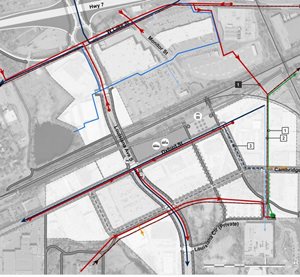
In most parts of the region, TOD planning involves developed areas rather than large, greenfield developments. As a result, land use planning for TOD focuses on infill, redevelopment, retrofitting, and intensification. New development will often replace obsolete commercial and industrial uses. Planning will emphasize the needs of pedestrians, including the safety, ease, and quality of walking routes. Other considerations include the form, function, and location of public and semi-public open spaces.
Retrofitting
Retrofitting in a developed area addresses deficiencies in public infrastructure and impediments to redevelopment. For TOD, retrofitting might include constructing new streets or pedestrian connections as redevelopment occurs. It could also mean working on challenging infill sites or adapting outdated buildings into marketable new uses. Retrofitting costs money, but may be necessary to create a more pedestrian-friendly environment and to improve a station area’s market conditions for TOD.

Redevelopment
Many redevelopment opportunities involve locations that are automobile-oriented, low-density, and no longer competitive. The retail market changes rapidly, contributing to an oversupply of retail space. Some larger sites are easier to redevelop into higher-density and/or mixed-use developments. Often located on transit corridors, these sites give future residents access to transit. Additional residential density can also strengthen the market for local retail.
Obsolete industrial uses may also be candidate sites for redevelopment, but cities should carefully weigh the potential loss of industrial employment versus the benefits of redevelopment for non-employment uses.
Property Owner Engagement
Planning often involves presenting images or maps to the public that show ideas about possible future development on specific property. It is essential to involve property owners and businesses early and often during this process. Images and drawings can be helpful, but ideas that come out of a shared process are more likely to be implemented.
Case Studies:
- Lake Street Station, Minneapolis, METRO Blue Line
- Vandalia Tower, St. Paul, METRO Green line
- Apple Valley Downtown, METRO Red Line (COMING SOON)
- Boulder Junction, Colorado (COMING SOON)
- Englewood Station, Colorado (COMING SOON)
Resources: